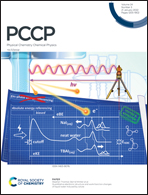A catalyzed E/Z isomerization mechanism of stilbene using para-benzoquinone as a triplet sensitizer†
Abstract
Sensitizer molecules affect not only the quantum yield but also the selectivity of photochemical reactions. For an appropriate design of sensitized photochemical processes, we need to elucidate the reaction mechanism in detail. Here we investigated the mechanism of photoisomerization of stilbene via the triplet state with a para-benzoquinone sensitizer using density functional theory. In general, the isomerization of stilbene via the triplet state exhibits (Z)-selectivity (cis-selectivity); however, the para-benzoquinone sensitizer changes it to (E)-selectivity (trans-selectivity). The calculations showed that stilbene and para-benzoquinone form stable exciplexes having a preoxetane structure. The E/Z isomerization occurred via this exciplex, in which para-benzoquinone acted as a photocatalyst rather than a sensitizer only providing excitation energy. The spin-density distribution of the exciplex differed from the isolated stilbene in the triplet state. Therefore, the stilbene moiety could take (E)-conformation in the exciplex. The intermolecular charge-transfer drove the exciplex formation. This specific reaction mechanism originated from the electron-accepting ability of para-benzoquinone in the triplet state.



 Please wait while we load your content...
Please wait while we load your content...